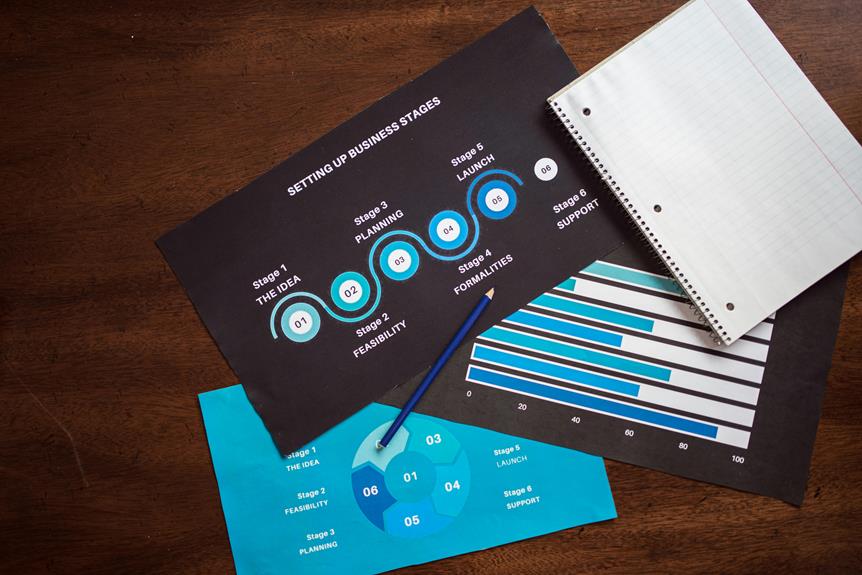When it comes to refining your approach, updating competitor content is a task that requires finesse. You might find opportunities by analyzing how competitors use keywords, revealing content gaps you can fill. Monitoring their backlinks could open doors for new partnerships, while assessing the quality of their content can help ensure clarity and accuracy in your own. Staying current with trends and optimizing for featured snippets may enhance your visibility. But how do you ensure you're not just keeping up, but staying ahead? Let's explore techniques that can transform your content strategy.
Analyze Competitor Keywords
Analyzing competitor keywords is crucial for staying ahead in the digital marketing arena. By understanding which keywords your competitors rank for, you gain valuable insights into their successful strategies, helping you identify gaps and opportunities.
Start by researching the top competitors in your industry. Use tools like SEMrush, Ahrefs, or Moz to dissect their keyword profiles. Look for high-performing keywords they target that you might be overlooking.
Next, categorize these keywords by their intent: informational, navigational, or transactional. This will guide you in tailoring your content to match user needs at different stages of their journey. When you spot high-volume keywords with low competition, seize the chance to optimize your content for them, potentially improving your search visibility.
Keep an eye on long-tail keywords. They mightn't have the highest search volume, but they often come with lower competition and higher conversion rates. Competitors might overlook these, giving you a strategic advantage.
Analyze trends in keyword usage over time as well. This will help you anticipate shifts in audience interest and adjust your strategy proactively.
Don't just focus on individual keywords; consider the broader context. Look at how competitors use keywords in their meta titles, descriptions, headers, and throughout their content. This can reveal patterns in their SEO practices and suggest tweaks for your own approach.
Assess Content Quality

To effectively assess content quality, start by evaluating writing clarity to ensure your message resonates with the audience.
Analyze information accuracy by verifying facts and sources, which builds trust and authority.
Evaluate Writing Clarity
When evaluating writing clarity, focus on how effectively the content communicates its intended message to the audience. Clear writing ensures that readers can easily grasp the main ideas without unnecessary confusion.
To assess clarity, consider these aspects:
1. Simplicity of Language: Use straightforward language to express complex ideas. Avoid jargon unless necessary, and when you must use it, provide clear explanations.
Simplicity aids in retaining the audience's attention and understanding.
2. Logical Structure: Ensure the content follows a logical progression. Each paragraph should flow naturally into the next, maintaining coherence throughout the piece.
Transitions are crucial for guiding readers smoothly from one idea to the next, preventing any disruption in comprehension.
3. Conciseness and Precision: Be concise, using only the words necessary to convey your point.
Precision in language use means choosing the exact words to reflect your message without ambiguity. This minimizes the risk of misinterpretation and enhances the reader's experience.
Analyze Information Accuracy
In the realm of content creation, ensuring information accuracy is paramount to maintaining your credibility with the audience. Analyzing the accuracy of your content isn't just about fact-checking once; it's an ongoing process of validation. Start by cross-referencing your data with reliable sources. Utilize authoritative databases, peer-reviewed journals, and government publications to ensure your content stands on solid ground.
You need to verify that statistics and claims are current. Outdated information can undermine trust and, ultimately, your authority in the field. Regularly update your content by setting a review schedule. Consistency in revisiting and refreshing your material ensures everything remains relevant and factual.
Engage with recent developments in your industry. Being aware of the latest news, trends, and studies allows you to adjust your content proactively. This not only enhances accuracy but also positions you as a thought leader.
Moreover, when analyzing your competitors, pinpoint discrepancies in their content. By addressing these gaps in your work, you not only improve your own accuracy but also offer enhanced value to your audience. In doing so, you cultivate a reputation for reliability and trustworthiness.
Check Visual Engagement
Visual engagement plays a crucial role in assessing the overall quality of your content. To ensure you're standing out, you need to evaluate how your visuals contribute to user experience. A well-crafted visual can enhance understanding, keep readers interested, and even convey complex information more efficiently than text alone.
Here's how you can check visual engagement effectively:
- Analyze Visual Appeal: Ask yourself whether the visuals are aesthetically pleasing and aligned with your brand. High-quality images, consistent color schemes, and clean layouts can greatly influence a viewer's perception of your content.
- Assess Alignment with Content: Evaluate if the visuals complement and enhance the accompanying text. They should serve a purpose, whether it's to illustrate a point, break up text, or guide the reader through your content. Misaligned visuals can confuse or distract your audience.
- Measure Engagement Metrics: Use tools to track how visuals impact user behavior. Metrics such as time spent on page, scrolling patterns, and bounce rates can indicate whether your visuals are engaging viewers or causing them to exit early.
Identify Content Gaps

While striving to outpace competitors, identifying content gaps becomes crucial for any successful content strategy. You must delve deep into your competitor's content to uncover missed opportunities—or areas where they mightn't be fully serving the audience's needs.
Start by analyzing their content topics, formats, and types to determine if there are subjects they've overlooked or content forms they haven't fully utilized. This involves not just looking at what exists but also understanding what's missing.
Examine their keywords and themes. Are there popular industry topics that they haven't covered? Additionally, consider emerging trends or new technologies that haven't yet been addressed. By identifying these gaps, you can position yourself as a thought leader, offering fresh insights and solutions that others haven't tapped into.
Beyond topics, think about the depth and breadth of content. Perhaps your competitors offer introductory-level information, but nothing for advanced users. Or maybe they focus heavily on product features without delving into real-world applications. These are opportunities for you to fill the void with comprehensive, valuable content that meets your audience's needs.
You should also assess the content's format. If competitors rely heavily on text, explore creating videos, podcasts, or interactive content. Offering diverse formats can engage different audience segments and keep your content dynamic.
Evaluate User Engagement

After pinpointing content gaps, it's important to focus on how users engage with your content compared to your competitors'. Understanding user engagement helps you gauge which content resonates and where you might need improvements.
Analyzing user engagement isn't just about numbers; it's about understanding behavior, preferences, and intent.
First, evaluate how your audience interacts with your content. Are they commenting, sharing, or simply bouncing off the page? Compare these metrics with those of your competitors. Tools like Google Analytics and social media insights can provide valuable data. Look at time on page, click-through rates, and social shares to determine which content keeps users engaged.
Next, examine the formats that drive engagement. Does your audience prefer videos, infographics, or long-form articles? Compare your content formats with those of your competitors to see what works best. Sometimes, a simple change in presentation can significantly boost engagement.
Finally, delve into the comments and discussions generated by your content. Are users asking questions, or are there recurring themes in their feedback? This qualitative data offers insight into what your audience values and where they see gaps. Comparing this with your competitors' content can reveal unique opportunities for engagement.
Here's a concise checklist to get started:
- Analyze user behavior metrics: Compare time on page, bounce rates, and social shares with competitors.
- Evaluate content formats: Determine which formats drive the most engagement and adapt accordingly.
- Examine user feedback: Use comments and discussions to understand user preferences and improve content.
Update Outdated Information

To ensure your content remains relevant and engaging, start by identifying key information gaps that may have emerged since the last update.
Verify current data sources to maintain accuracy, as relying on outdated facts can undermine credibility.
Identify Key Information Gaps
In the ever-evolving digital landscape, identifying key information gaps is crucial for staying ahead of competitors and ensuring content remains relevant. By spotting these gaps, you can fill them with valuable insights, making your content more appealing and useful to your audience.
Understanding where your competitors fall short allows you to capitalize on their weaknesses and create superior content.
First, examine your competitors' content closely. Look for areas where they might lack depth, accuracy, or timeliness. This helps you understand what your target audience might be missing out on.
- Analyze Competitor Content: Scrutinize the coverage of key topics. Are there questions left unanswered or emerging trends not discussed?
- Review Audience Engagement: Check comments, shares, and feedback on competitor content. This can reveal what your audience is interested in but not finding elsewhere.
- Conduct Keyword Research: Identify keywords your competitors rank for but aren't fully utilizing. This can highlight potential topics to explore in more detail.
Verify Current Data Sources
Recognizing the importance of accuracy, verifying current data sources is essential for maintaining the credibility and relevance of your content. When you ensure that the information you present is accurate and up-to-date, you build trust with your audience and stand out in a crowded digital landscape. Begin by checking the publication date of your sources; outdated data can mislead your readers and undermine your authority. Cross-referencing with multiple reliable sources is a wise practice, ensuring the information's consistency and validity.
Consider the following steps to verify data:
| Step | Action | Benefit |
|---|---|---|
| 1. Check Dates | Look at the publication date | Ensures information is current |
| 2. Cross-Reference | Compare with other sources | Confirms accuracy |
| 3. Evaluate Source | Assess the credibility of the source | Ensures reliability |
| 4. Update Regularly | Set reminders for periodic checks | Maintains ongoing relevance |
| 5. Feedback Loop | Encourage reader feedback | Identifies potential inaccuracies |
Refresh With Latest Trends
Staying ahead of the curve requires vigilance and adaptability. To ensure your content remains relevant and engaging, you need to refresh it with the latest trends. This isn't just about adding flashy buzzwords; it's about integrating meaningful updates that resonate with your audience.
Analyzing competitors' content can reveal insights into emerging trends, helping you craft content that not only stands out but also aligns with current interests.
To effectively refresh your content, consider the following strategies:
- Monitor Industry Influencers: Follow key influencers and thought leaders in your niche. Their insights can offer a glimpse into upcoming trends, allowing you to incorporate these themes into your content before your competitors do.
- Utilize Trend Analysis Tools: Tools like Google Trends and BuzzSumo provide valuable data on trending topics. By understanding what's gaining traction, you can update your content to reflect these interests, ensuring it remains relevant and engaging.
- Engage with Your Audience: Regularly solicit feedback from your audience through surveys or social media interactions. Their preferences and pain points can guide you in identifying trends that matter most to them, ensuring your updates are both timely and impactful.
Embrace these strategies to keep your content fresh and ahead of the competition.
Optimize for Featured Snippets

Capturing featured snippets can significantly enhance your content's visibility and drive more traffic to your site. These coveted positions in search results provide users with quick answers and entice them to click through for more detailed information.
To optimize your content for featured snippets, start by identifying the questions your target audience frequently asks. Use tools like Google's "People Also Ask" and keyword research platforms to get a sense of these queries.
Crafting clear, concise answers is crucial. Your content should directly address these questions, ideally in a format that's easily digestible. Use bullet points, numbered lists, or short paragraphs to improve readability. Ensure your answer is positioned near the beginning of your content; Google often pulls snippets from the top of a page.
Structured data plays a vital role, too. Implementing schema markup can help search engines understand your content better, increasing the likelihood of snagging a featured snippet spot. While it doesn't guarantee it, structured data provides an edge by organizing your information in a way that's favorable to search algorithms.
Don't forget to analyze your competitors. Examine what types of content and formats currently hold featured snippets for your target keywords. This insight can guide your approach, showing you what's working and where there's room for improvement.
Lastly, continuously monitor your performance. Use analytics tools to track changes and adjust your strategy as needed. By staying proactive, you'll maintain your content's competitiveness in the ever-evolving search landscape, ensuring it remains a prime candidate for featured snippets.
Enhance Visual Content

While optimizing for featured snippets can elevate your content's visibility, enhancing visual content offers a powerful complement to your strategy. Visuals not only capture attention but also aid in understanding and retention. By focusing on the quality and relevance of visual elements, you can create a more engaging experience for your audience, setting your content apart from competitors.
To get started on enhancing your visual content, consider these key strategies:
- Use High-Quality Images and Graphics: Invest in high-resolution images and custom graphics that align with your brand's message. Avoid stock images that can appear generic and uninspiring. Instead, opt for visuals that speak directly to your audience's needs and interests. A well-chosen image can immediately elevate the perceived value of your content.
- Incorporate Infographics: Infographics are a fantastic way to present complex data in an easily digestible format. They can break down detailed information into visually appealing segments, making it easier for your audience to grasp and remember key points. When done right, infographics can be shared across platforms, broadening your content's reach and impact.
- Optimize Visuals for SEO: Don't overlook the importance of SEO when it comes to visuals. Use descriptive file names, alt text, and captions to ensure search engines can index your images effectively. This can help boost your visibility in image search results, driving more traffic to your site.
Improve Content Readability

To improve content readability, start by simplifying complex language to ensure your message is clear and engaging.
You should also enhance visual elements like headings, bullet points, and images to break up text and guide the reader's eye.
Simplify Complex Language
Anyone who's tried to make their content more engaging knows that simplifying complex language is key to improving readability. When your audience can easily understand your message, they're more likely to stay engaged and act on your content.
Here's how you can simplify complex language effectively:
- Use Short Sentences: Break down long, convoluted sentences into shorter, more digestible ones. This doesn't mean dumbing down your content; it means making it more approachable. Short sentences help maintain the reader's focus and make your points clearer.
- Choose Common Words: Opt for everyday language instead of jargon or technical terms. If technical language is necessary, provide a brief explanation. This makes your content accessible to a broader audience, not just those familiar with industry-specific terms.
- Active Voice: Using active voice makes your writing more direct and dynamic. It also reduces unnecessary words, making your content easier to follow. For example, say "We simplified the process" instead of "The process was simplified by us."
Simplifying language doesn't mean oversimplifying ideas. It's about clarity, making sure your audience grasps your message quickly and efficiently.
Enhance Visual Elements
Visual elements play a critical role in capturing and sustaining your audience's attention. When you enhance these elements, you're not just adding decoration; you're improving the content's readability and engagement.
Start by evaluating your current visuals—charts, images, infographics—and consider their effectiveness. Do they convey the intended message quickly and clearly? It's vital to ensure visuals aren't only eye-catching but also informative.
Next, consider consistency and alignment with your brand's style. Using a coherent color scheme and typography across visuals can reinforce brand identity. Remember, clarity is key, so avoid cluttered designs that might confuse rather than clarify. Instead, use white space strategically to enhance readability and guide the viewer's eye naturally.
Moreover, interactive elements like clickable infographics or videos can increase engagement significantly. They offer dynamic ways for users to interact with your content, making it memorable and more likely to be shared.
Always optimize visual elements for different devices, ensuring they display properly on mobile and desktop alike.
Ultimately, enhancing visual elements isn't just about aesthetics; it's about creating a seamless, engaging experience that complements and amplifies your message.
Incorporate User Feedback

Incorporating user feedback is essential to refining and enhancing your content's impact. By listening to your audience, you can identify areas where your content might be falling short and make necessary improvements. User feedback provides direct insight into what your readers value, need, and expect from your content.
It highlights opportunities for you to surpass your competitors by addressing gaps or errors they might've overlooked.
Here's how you can effectively incorporate user feedback into your content strategy:
1. Collect Feedback Actively: Engage with your audience through surveys, comment sections, or social media platforms. Encourage readers to share their thoughts and suggestions. This not only helps you gather valuable insights but also makes your audience feel valued and involved in your process.
2. Analyze and Prioritize Feedback: Not all feedback will be equally useful. Distinguish between constructive criticism and less actionable suggestions. Focus on comments that repeatedly arise, as these often indicate widespread issues.
Prioritizing feedback helps you allocate resources effectively, ensuring that the most pressing concerns are addressed first.
3. Implement Changes and Communicate: Once you've identified the feedback to act upon, make the necessary updates to your content. Communicate these changes openly with your audience, highlighting how their input made a difference.
This transparency builds trust and encourages ongoing engagement.
Monitor Competitor Backlinks

Monitoring competitor backlinks is a crucial strategy for staying ahead in the digital landscape. By analyzing where your competitors are getting their links, you can uncover opportunities to enhance your own SEO strategy.
Start by using tools like Ahrefs, SEMrush, or Moz to track competitor backlinks effectively. These platforms provide insights into the sources, quality, and anchor texts of the links pointing to your competitors' sites.
When you know where competitors are getting their backlinks, you can identify potential partnerships or guest blogging opportunities. Reach out to those same websites or find similar ones within your niche. This strategy not only helps you build relationships but also boosts your own domain authority.
Pay attention to the quality of the backlinks. Competitors might've links from high-authority sites that drive significant traffic. Aim to secure links from similar authoritative sites to enhance your credibility.
If you notice broken links pointing to your competitors, offer your content as a replacement. This tactic, known as broken link building, can be a win-win: you provide a solution while gaining a valuable backlink.
Additionally, analyze the anchor text used in competitor backlinks. This can reveal the keywords they're targeting. Compare these with your own keyword strategy and adjust accordingly.
If you identify gaps in their strategy, capitalize on them to gain a competitive advantage.
Conclusion
You've got the groundwork to grow and gain ground in the competitive content landscape. By analyzing and assessing, you can accurately address areas that need attention. Constantly updating outdated info keeps content current. Engage and enhance your audience's experience by integrating insightful improvements. Backlink monitoring can bolster beneficial partnerships. Stay sharp with structure, seek snippets, and see success soar. These strategies serve as your stepping stones to thriving in the ever-evolving digital domain.


